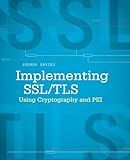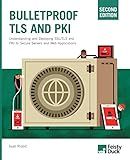Best SSL Certificates to Buy in December 2025

SSL/TLS Under Lock and Key: A Guide to Understanding SSL/TLS Cryptography



Implementing SSL / TLS Using Cryptography and PKI



Bulletproof TLS and PKI, Second Edition: Understanding and Deploying SSL/TLS and PKI to Secure Servers and Web Applications



FREE SSL CERTIFICATES: Secure your Web server with free Let's Encrypt Certificates Guide to fully automate the process of creating and renewing certificates. (CTS SOLUTIONS IT-PRO E-Books Book 4)



SSL server certificate creation manual for CentOS 8/7 (Japanese Edition)



IIS Essentials: From Installation to Maintenance - The Ultimate Guide: Unleashing the Power of Your Web Server



$15M Line Item That Doesn't Exist: The Invisible Certificate Management Tax and How Automation Eliminates 95% of It (Your Infrastructure Intelligence Book 3)



Mastering NGINX Second Edition



Secure Your WordPress Website with HTTPS for free: A Visual Step-by-Step Guide to Securing Your Website with SSL (Webmaster Series)



My own Certificate Authority: Create your own graphical CA for Intranets with Open Source Software for Windows, Linux and MAC (CTS SOLUTIONS IT-PRO E-Books Book 1)


To redirect HTTP to HTTPS in Apache web server, you can use the mod_rewrite module to create a rewrite rule in the server configuration files. You need to specify a condition that checks if the request is not already using HTTPS, and then create a rewrite rule that redirects the request to the HTTPS version of the URL.
You can do this by editing the Apache configuration file (typically located at /etc/apache2/apache2.conf or /etc/httpd/httpd.conf) and adding the following lines:
RewriteEngine On RewriteCond %{HTTPS} off RewriteRule ^ https://%{HTTP_HOST}%{REQUEST_URI} [L,R=301]
This rule checks if the HTTPS variable is off (meaning the request is using HTTP) and then redirects the request to the HTTPS version of the URL with a 301 (permanent) redirect status. Save the configuration file and restart the Apache server for the changes to take effect.
Once the redirection rule is in place, all HTTP requests to your server will be automatically redirected to the HTTPS version of the URL, ensuring secure communication between the server and the client.
How to enable SSL on Apache web server?
To enable SSL on an Apache web server, follow these steps:
- Install the mod_ssl module: The mod_ssl module provides strong cryptography for the Apache web server. You can install it using your package manager. For example, on Debian-based systems, you can use the following command:
sudo apt-get install libapache2-mod-ssl
- Generate SSL certificate and key: You can either generate a self-signed certificate or obtain one from a trusted Certificate Authority (CA). To generate a self-signed certificate, you can use the following command:
sudo openssl req -x509 -nodes -days 365 -newkey rsa:2048 -keyout /etc/ssl/private/apache-selfsigned.key -out /etc/ssl/certs/apache-selfsigned.crt
- Configure Apache to use SSL: Open the Apache configuration file (usually located in /etc/apache2/sites-available/) and add the following lines to enable SSL:
SSLEngine on SSLCertificateFile /etc/ssl/certs/apache-selfsigned.crt SSLCertificateKeyFile /etc/ssl/private/apache-selfsigned.key
- Restart Apache: Once you have enabled SSL in the Apache configuration, restart the Apache service for the changes to take effect. On Debian-based systems, you can use the following command:
sudo systemctl restart apache2
After completing these steps, your Apache web server should now be configured to use SSL. You can verify that SSL is enabled by accessing your website using https:// in the URL.
How to create a 301 permanent redirect from http to https in Apache configuration?
To create a 301 permanent redirect from http to https in Apache configuration, you can follow these steps:
- Open your Apache configuration file. This file is usually located in the /etc/apache2/ directory and is named either httpd.conf or apache2.conf. You can open the file using a text editor such as nano or vi.
- Find the Virtual Host block for your website. This block contains the configuration settings for your website.
- Add the following lines within the Virtual Host block:
RewriteEngine On RewriteCond %{HTTPS} off RewriteRule ^ https://%{HTTP_HOST}%{REQUEST_URI} [L,R=301]
These lines enable the RewriteEngine, check if the request is not already using https, and then redirect the request to the https version of the URL with a 301 redirect status.
- Save the configuration file and restart Apache to apply the changes. You can do this by running the following command in your terminal:
sudo systemctl restart apache2
After completing these steps, all traffic to your website using http will be automatically redirected to the https version of the URL with a 301 permanent redirect.
What is Mixed Content and how does it impact https redirection?
Mixed content refers to a situation where a website served over HTTPS also contains resources (such as images, videos, scripts, stylesheets) that are loaded over HTTP. This can pose a security risk because mixed content can be intercepted and altered by a third party, compromising the integrity of the website and the information exchanged between the website and the user.
When a website with mixed content is accessed over HTTPS, browsers may display a warning or block the insecure content, causing a disruption in the user experience. In some cases, the browser may not load the insecure content at all, leading to broken functionality on the website.
As a result, it is important for website owners to ensure that all resources on their website are served over HTTPS to maintain security and avoid issues with mixed content. This can be achieved by updating all URLs in the website code to use HTTPS, ensuring that all resources are loaded securely.
What is a secure socket layer (SSL) and how does it encrypt data?
A Secure Socket Layer (SSL) is a standard security protocol used to establish an encrypted link between a web server and a browser. This link ensures that all data passed between the server and the browser remains private and secure.
SSL works by using a combination of asymmetric and symmetric encryption. Asymmetric encryption involves using a pair of keys - a public key and a private key. When a browser connects to a server, the server sends its public key to the browser to establish a secure connection. The browser then generates a symmetric session key, encrypts it with the server's public key, and sends it back to the server. The server decrypts the symmetric key using its private key, and both the server and the browser now have a shared session key to encrypt and decrypt data sent between them.
Once the secure connection is established, all data sent between the server and the browser is encrypted using the shared session key. This encryption ensures that even if a hacker intercepts the data, they will not be able to access or read it without the shared key. Overall, SSL encryption helps to protect sensitive information such as passwords, credit card numbers, and personal details from being intercepted and stolen by hackers.
How to update existing htaccess file for http to https redirection?
To update an existing .htaccess file for HTTP to HTTPS redirection, you can follow these steps:
- Open the .htaccess file in your website's root directory using a text editor.
- Add the following code to redirect all HTTP traffic to HTTPS:
RewriteEngine On RewriteCond %{HTTPS} off RewriteRule ^ https://%{HTTP_HOST}%{REQUEST_URI} [L,R=301]
- Save the .htaccess file and upload it back to your server.
- Test the redirection by typing your website's URL with HTTP in the browser. It should automatically redirect to HTTPS.
- You can also test the redirection using online tools like Redirect-Check to verify that the HTTP to HTTPS redirection is working correctly.
By following these steps, you can update your existing .htaccess file for HTTP to HTTPS redirection.
What is the maximum SSL/TLS version supported by Apache?
The maximum SSL/TLS version supported by Apache is TLS 1.3.
